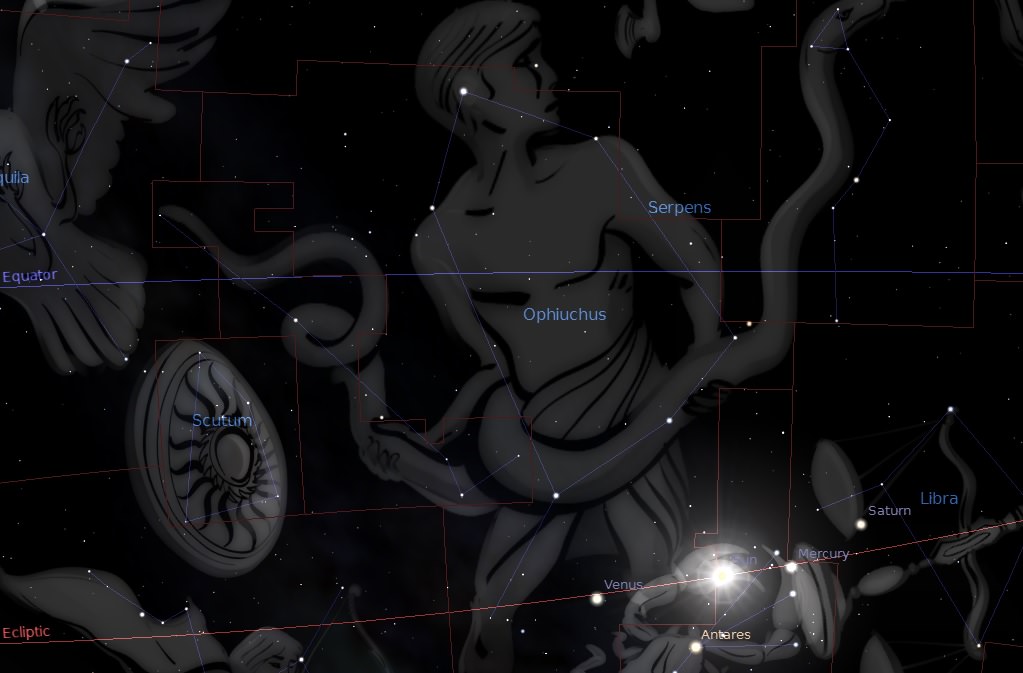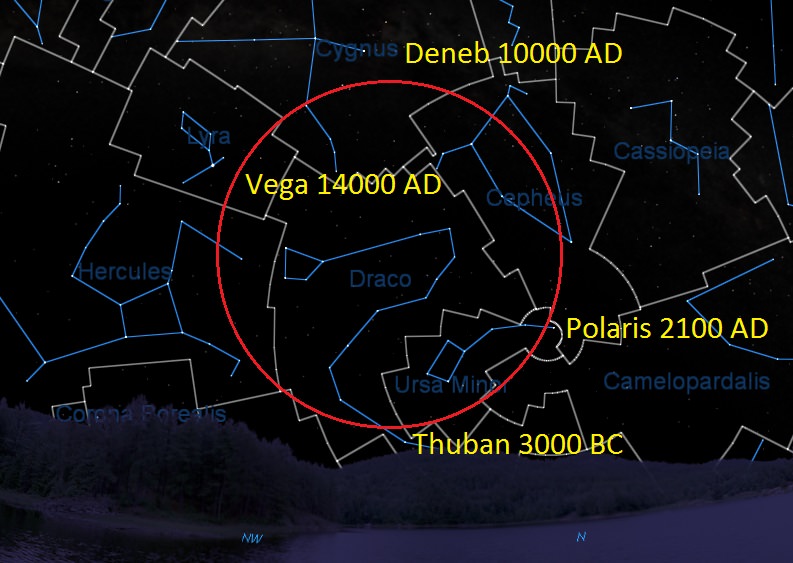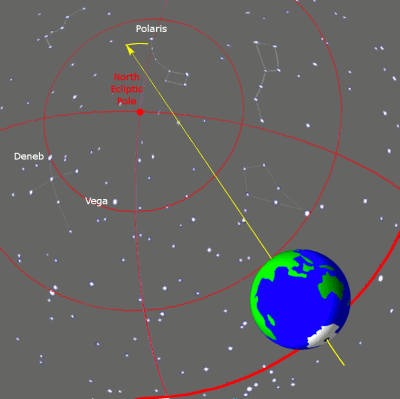Did you know that there are 88 constellations in the night sky? Over the course of several thousand years, human beings have cataloged and named them all. But only 12 of them are particularly famous and continue to play an active role in our astrological systems. These are known as the zodiac signs, 12 constellations that correspond to the different months of the year.
Each of these occupies a sector of the sky which makes up 30° of the ecliptic, starting at the vernal equinox – one of the intersections of the ecliptic with the celestial equator. The order of these astrological signs is Aries, Taurus, Gemini, Cancer, Leo, Virgo, Libra, Scorpio, Sagittarius, Capricorn, Aquarius and Pisces. Here are all the zodiac signs and their dates. If your birthday falls within one of those date ranges, that’s your zodiac sign.
Granted, modern science has shown astrology to be an ancient fallacy, a way of connecting patterns in celestial movements to events and behaviors here on Earth. But for ancient people, such patterns were necessary given the fact that they lacked an understanding of human psychology, astronomy, and that Earth was not the center of the universe.
The concept of the zodiac originated in Babylon in the 2nd millennium BCE, and was later influenced by Hellenistic (Ancient Greek), Roman, and Egyptian culture. This resulted in a mix of traditions, where the 12 zodiac symbols were associated with the 12 Houses – different fields of experience associated with the various planets – and the four classical elements (Earth, Wind, Water and Fire).

In essence, astrology maintains that celestial phenomena are related to human activity, so the signs are held to represent certain characteristics of behavior and personality traits. What we know today as astrology comes from the 2nd century AD, as it was formally described by Ptolemy in his work, Tetrabiblos.
This book was responsible for the spread of astrology’s as we know it across Europe and the Middle East during the time of the Roman Empire. These traditions have remained relatively unchanged for over seventeen centuries, though some alterations have been made due to the subsequent discoveries of the other planets in our Solar System.
Naturally, the birth of the modern psychology, biology and astronomy has completely discredited the notion that our personalities are determined by birth signs, the position of the stars or the planets. Given what we know today of the actual elements, the movements of the planets, and the forces that govern the universe, astrology is now known for being little more than superstition.
What’s more, the dates of the ‘star signs’ were assigned over 2,000 years ago, when the zodiac was first devised. At that time, astronomers believed that the Earth’s position was fixed in the universe, and did not understand that the Earth is subject to precession – where Earth’s rotational and orbital parameters slowly change with time. As such, the zodiac signs no longer correspond to constellations of stars that appear in night sky.
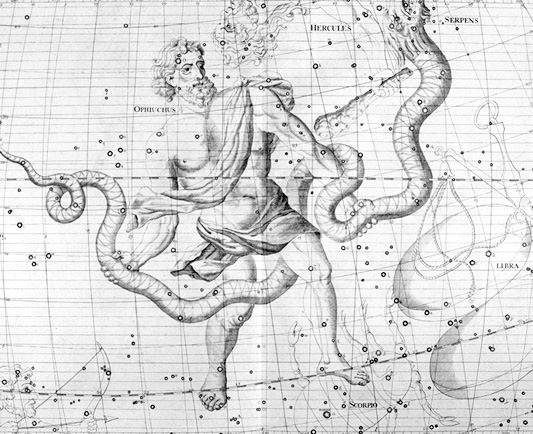
And last, but certainly not least, there is the issue of the missing 13th sign, which corresponds to the constellation Ophiuchus. Over 2000 years ago, this constellation was deliberately left out, though the Sun clearly passes in front of it after passing in front of Scorpius (aka. Scorpio) and before reaching Sagittarius.
It is unclear why ancient astrologers would do this, but it is a safe bet that they wanted to divide the 360° path of the Sun into 12 equal parts. But the true boundaries that divide the constellations, as defined by the International Astronomical Union (IAU), are not exact. And Ophiuchus actually spends more time behind the Sun than its immediate neighbor (19 days compared to Scorpius’ 12).
To find out what zodiac sign you were really born under, check out this story from BBC’s iWonder. And in the meantime, here are the zodiac signs, listed in order along with what they mean, and some interesting facts associated with their respective constellations:
![]()
Aries: March 21 – April 19
The sign of Aries, which covers 0° to 30° of celestial longitude, is represented by The Ram, which is based on the Chrysomallus – the flying ram that provided the Golden Fleece in Greek mythology. Aries is associated with the First House, known traditionally as Vita (Latin for life) and in the modern context as the “House of Self”. Aries is associated with Fire, and the ruling celestial body of Aries is Mars.
The Aries constellation is also home to Teegarden’s Star, one of Sun’s closest neighbors, located approximately 12 light years away. It appears to be a red dwarf, a class of low temperature and low luminosity stars. And then there’s Alpha Areitis, which is easily spotted by the naked eye. Also known as “Hamal” – literally “head of the sheep” in Arabic – this star is located at the point where constellations angles downward to form an arc.
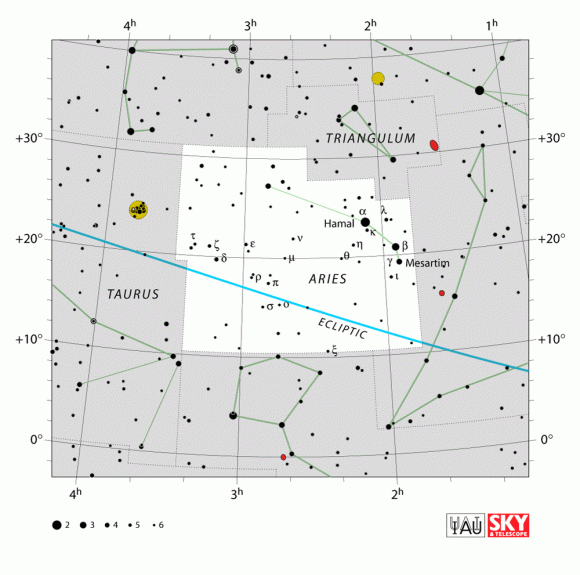
For those with telescopes, several galaxies can be spotted within the Aries constellation as well. These include the spiral galaxy NGC 772 and the large 13th magnitude NGC 697 spiral galaxy. NGC 972 is another, which is faint (at magnitude 12) and part of a galaxy group. And then there’s the dwarf irregular galaxy NGC 1156, which is considered a Magellanic-type galaxy with a larger than average core.
Aries is also home to several meteor showers, such as the May Arietids. This daylight meteor shower begins between May 4th and June 6th with maximum activity happening on May 16th. The Epsilon Arietids are also a daylight occurrence, and are active between April 25th to May 27th with peak activity on May 9th. And then there are the Daytime Arietids, which occur from May 22nd to July 2nd with a maximum rate of one a minute on June 8th.
To top it off, the Aries constellation contains several stars with extrasolar planets. For example, HIP 14810, a G5 type star, is orbited by three confirmed exoplanets, all of them giant planets (all Super-Earths). HD 12661, also a G-type main sequence star, has two orbiting planets (which appear to be Super-Jupiters). And HD 20367, a G0 type star, has one orbiting gas giant that roughly the same size as Jupiter.

Taurus: April 20 – May 20
The sign of Taurus, which covers 30° to 60° of celestial longitude, is represented by The Bull – which is based on the Cretan Bull that fathered the Minotaur and was killed by Theseus. Taurus is associated with the Second House, known by the Latin name of Lucrum (wealth) and by the modern name, “House of Value”, and the element Earth. The ruling celestial body of Taurus is Venus.
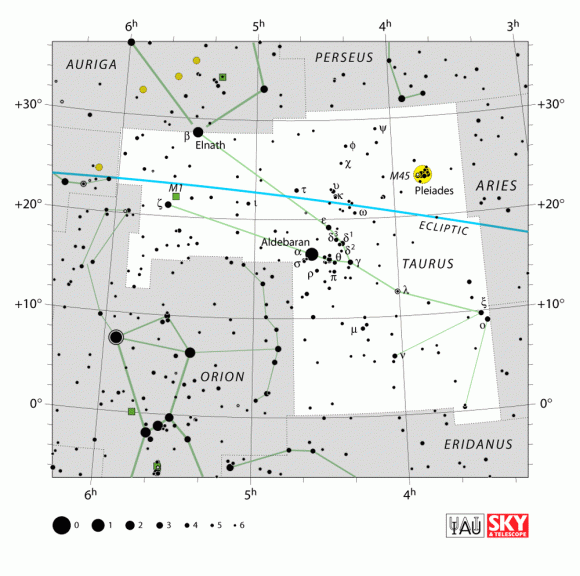
Taurus’ brightest star, Alpha Tauri, is also known by its traditional name, Al Dabaran (which was Latinized to become Aldebaran). The name, which is Arabic, literally means “the Follower” because of the way the Taurus constellation appears to follow the Pleiades star cluster across the sky. In Latin, it was traditionally known as Stella Dominatrix, but to Medieval English astronomers, it was known as Oculus Tauri – literally the “eye of Taurus.”
There is one major annual meteor shower associated with the constellation of Taurus: the annual Taurids, which peak on or about November 5th of each year and have a duration period of about 45 days. The maximum fall rate for this meteor shower is about 10 meteors per hour, with many bright fireballs often occurring when the parent comet – Encke – has passed near perihelion.
And speaking of Pleiades (aka. Messier 45, The Seven Sisters) this cluster of stars is located perpendicular to Aldebaran in the night sky, and is visible to the unaided eye. Although it is made up of over 1000 confirmed stars, this object is identifiable by its seven particularly bright blue stars (though as many as 14 up can be seen with the naked eye depending on local observing conditions).

Gemini: May 21 – June 20
The sign Gemini covers 60° to 90° of the celestial longitude, and is represented by The Twins. These are based on the Dioscuri of Greek mythology, two mortals that were granted shared godhood after death. Gemini is part of the Third House, traditionally named Fratres (Brothers) and currently known as the House of Communications. The associated element for Geminis is Air, and the ruling celestial body is Mercury.
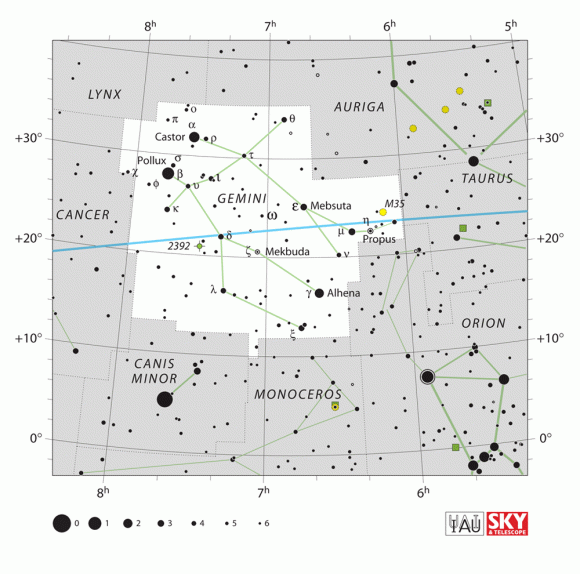
Gemini’s alpha and beta stars – aka. Castor and Pollux (“The Twins”) – are the easiest to recognize and can be spotted with the naked eye. Pollux is the brighter of the two, an orange-hued giant star of magnitude 1.2 that is 34 light-years from Earth. Pollux has an extrasolar planet revolving around it, as do two other stars in Gemini, a super-Jupiter which was confirmed in 2006.
There are two annual meteor showers associated with the constellation of Gemini. The first is the March Geminids, which peaks on or around March 22nd. The average fall rate is generally about 40 per hour (but this varies) and the meteors appear to be very slow, entering our atmosphere unhurriedly and leaving lasting trails.
The second meteor shower are the Geminids themselves, which peak on or near the date of December 14th, with activity beginning up to two weeks prior and lasting for several days. The Geminids are one of the most beautiful and mysterious showers, with a rate of about 110 per hour during a moonless night.
The Gemini constellation is also associated with Messier 35, a galactic open star cluster that is easily spotted with the naked eye. The star cluster is quite young, having formed some 100 million years ago, and is quite bright due to it having blown away most of its leftover material (i.e. nebular dust and gas) that went into the star formation process. Other open clusters in Gemini include NGC 2158, which lies directly southwest of M35 in the night sky.
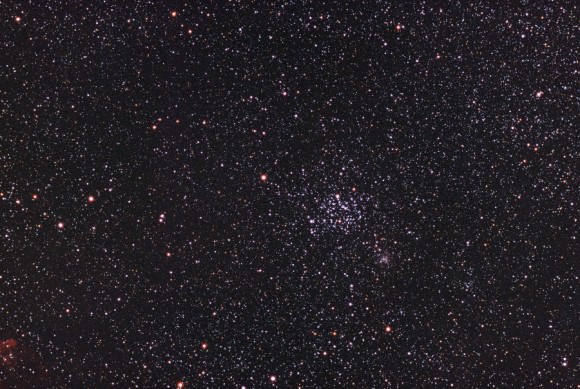
![]()
Cancer: June 21 – July 22
Cancer, which covers 90° to 120° of celestial longitude, is represented by The Crab – or Karkinos, a giant crab from Greek mythology that harassed Hercules during his fight with the Hydra. The sign is associated with the Fourth House – Genitor (Parent) in Latin, or the House of Home and Family in modern times. In terms of the elements, Cancers are characterized by the element of Water, and the ruling celestial body of Cancer is The Moon.
Cancer’s best known star is Beta Cancri, also known by its Arab name Altarf (“the End”). This 3.5 magnitude star is located 290 light-years from Earth and is a binary star system that consists of a spectral type K4III orange giant and a magnitude 14 red dwarf. This system is also home to a confirmed exoplanet, beta Cancri b, which is a Super-Jupiter with an orbital period of over 600 days.
In terms of deep-sky objects, Cancer is best known as being the home of Messier Object 44 (aka. Praesepe, or the Beehive Cluster), an open cluster located in the center of the constellation. Located 577 light-years from Earth, it is one of the nearest open clusters to our Solar System. M44 contains about 50 stars, the brightest of which are of the sixth magnitude.
The smaller, denser open cluster of Messier Object 67 can also be found in Cancer, which is 2500 light-years from Earth and contains approximately 200 stars. And so can the famous quasar, QSO J0842+1835, which was used to measure the speed of gravity in the VLBI experiment conducted by Edward Fomalont and Sergei Kopeikin in September 2002.
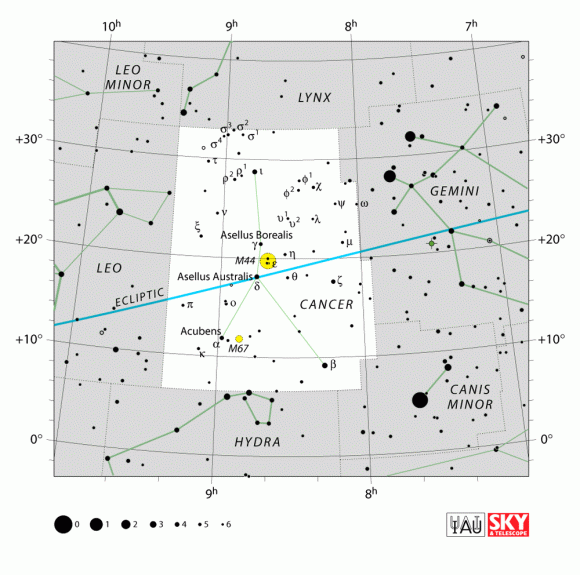
The active galaxy OJ 287 is also found in the Cancer constellation. Located 3.5 billion light years away from Earth, this galaxy has a central supermassive black hole that is one of the largest known (with 18 billion solar masses), and produces quasi-periodic optical outbursts. There is only one meteor shower associated with the constellation of Cancer, which is the Delta Cancrids. The peak date for this shower is on or about January 16t, and has been known to average only about 4 comets per hour (and the meteors are very swift).

Leo: July 23 – Aug. 22
Those born under the sign of Leo, which covers 120° to 150° of celestial longitude, carry the sign of The Lion – which is based on the Nemean Lion of Greek mythology, a lion that had an impenetrable hide. The sign of Leo is tied to the Fifth House, known in Latin as Nati (Children), or by its modern name, House of Pleasure. The sign of Leo is also associated with the element of Fire and the ruling celestial body of Leo is The Sun.
There are five annual meteor showers associated with the constellation Leo. The first is the Delta Leonid meteor stream, which begins between February 5th through March 19th every year. The activity peaks in late February, and the maximum amount of meteors averages around 5 per hour. The next is the Sigma Leonid meteor shower, which begins on April 17th. This is a very weak shower, with activity rates no higher than 1 to 2 per hour.
The next is the November Leonids, the largest and most dependable meteor shower associated with the Leo constellation. The peak date is November 17th, but activity occurs around 2 days on either side of the date. The radiant is near Regulus and this is the most spectacular of modern showers.
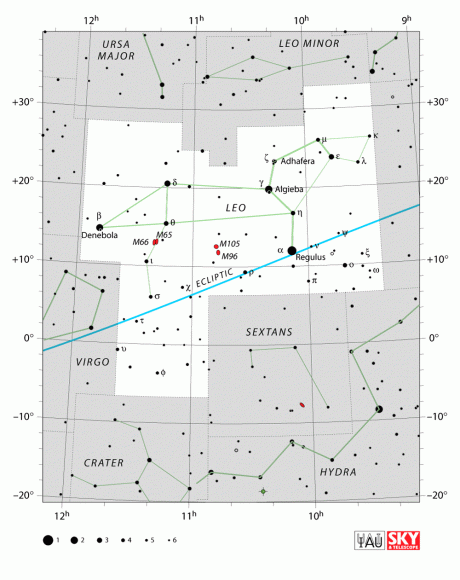
The shower is made more spectacular by the appearance of the Temple-Tuttle comet, which adds fresh material to the stream when it is at perihelion. The last is the Leo Minorids, which peak on or about December 14th, which is believed to produce around 10 faint meteors per hour.
Leo is also home to some of the largest structures in the observable universe. This includes many bright galaxies, which includes the Leo Triplet (aka. the M60 group). This group of objects is made up of three spiral galaxies – Messier 65, Messier 66, and NGC 3628.
The Triplet is at a distance of 37 million light-years from Earth and has a somewhat distorted shape due to gravitational interactions with the other members of the Triplet, which are pulling stars away from M66. Both M65 and M66 are visible in large binoculars or small telescopes, but seeing them in all of their elongated glory requires a telescope.
In addition, it is also home to the famous objects Messier 95, Messier 96, and Messier 105. These are spiral galaxies, in the case of M95 and M96 (with M95 being a barred spiral), while Messier 105 is an elliptical galaxy which is known to have a supermassive black hole at its center. Then there is the Leo Ring (aka. Cosmic Horseshoe) a cloud of hydrogen and helium gas, that orbits two galaxies found within this constellation.
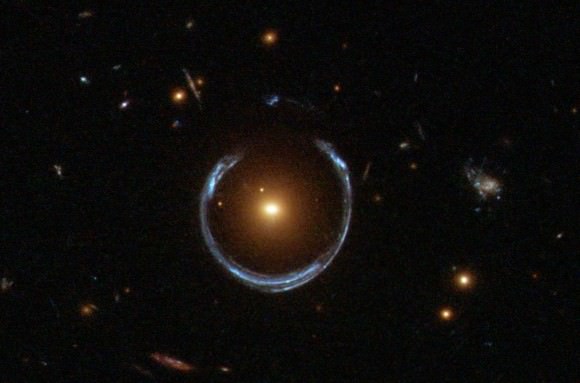

Virgo: Aug. 23 – Sept. 22
The sign of Virgo, which covers 150° to 180° of celestial longitude, is represented by the The Maiden. Based on Astraea from Greek mythology, the maiden was the last immortal to abandon Earth at the end of the Silver Age, when the gods fled to Olympus. Virgo is part of the Sixth House – Valetudo (Health) in Latin, or House of Health in modern times. They are also associated with the element of Earth and the ruling celestial body of Virgo is Mercury.
The brightest star in the Virgo constellation is Spica, a binary and rotating ellipsoidal variable – which means the two stars are so close together that they are egg-shaped instead of spherical – located between 240 and 260 light years from Earth. The primary is a blue giant and a variable star of the Beta Cephei type.
Besides Spica, other bright stars in Virgo include Beta Virginis (Zavijava), Gamma Virginis (Porrima), Delta Virginis (Auva) and Epsilon Virginis (Vindemiatrix). Other fainter stars that were also given names are Zeta Virginis (Heze), Eta Virginis (Zaniah), Iota Virginis (Syrma) and Mu Virginis (Rijl al Awwa). Virgo’s stars are also home to a great many exoplanets, with 35 verified exoplanets orbiting 29 of its stars.
The star 70 Virginis was one of the first planetary systems to have a confirmed exoplanet discovered orbiting it, which is 7.5 times the mass of Jupiter. The star Chi Virginis has one of the most massive planets ever detected, at a mass of 11.1 times that of Jupiter. The sun-like star 61 Virginis has three planets: one is a super-Earth and two are Neptune-mass planets.
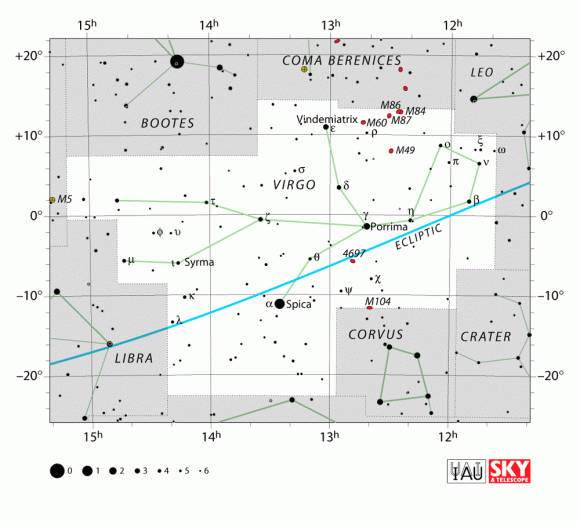
![]()
Libra: Sept. 23 – Oct. 22
The sign of Libra covers 180° to 210° of celestial longitude. It is represented by the symbol of The Scales, which is based on the Scales of Justice held by Themis, the Greek personification of divine law and custom and the inspiration for modern depictions of Lady Justice. Libra is part of the Seventh House – Uxor (Spouse) or House of Partnership, are associated with the element of Air, and the ruling celestial body is Venus.
Two notable stars in the Libra constellation are Alpha and Beta Librae – also known as Zubenelgenubi and Zubeneschamali, which translates to “The Southern Claw” and “The Northern Claw”. Alpha Libae is a double star consisting of an A3 primary star with a slight blue tinge and a fainter type F4 companion, both of which are located approximately 77 light years from our Sun.
Beta Librae is the brighter of the two, and the brightest star in the Virgo constellation. This is a blue star of spectral type B8 (but which appears somewhat greenish) which is located roughly 160 light years from Earth. Then there’s Gamma Librae (also called Zubenelakrab, which means “the Scorpion’s Claw”) which completes the Scorpion sign. It is an orange giant of magnitude 3.9, and is located 152 light-years from Earth.
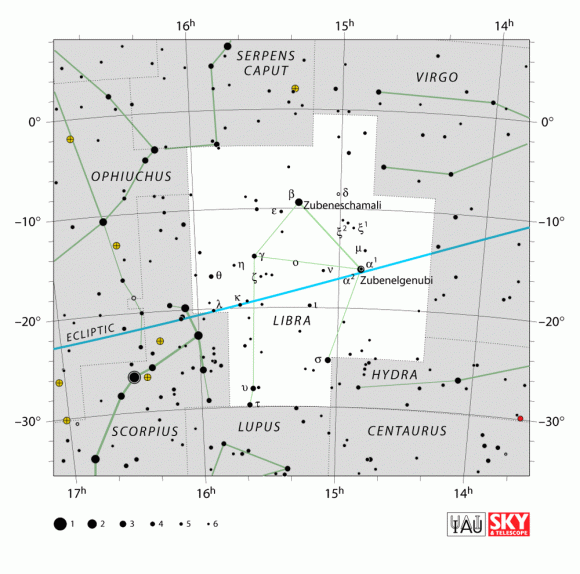
Libra is home to the star Gliese 581, which has a planetary system consisting of at least 6 planets. Both Gliese 581 d and Gliese 581 g are considered to be some of the most promising candidates for life. Gliese 581 c is considered to be the first Earth-like exoplanet to be found within its parent star’s habitable zone. All of these exoplanets are of significance for establishing the likelihood of life outside of the Solar System.
Libra is also home to one bright globular cluster, NGC 5897. It is a fairly large and loose cluster, has an integrated magnitude of 9, and is located 40,000 light-years from Earth.

Scorpio: Oct. 23 – Nov. 21
The sign of Scorpio covers 210° to 240° of celestial longitude. Scorpio is represented by The Scorpion, which is based on Scorpius – a giant scorpion in Greek mythology sent by Gaia to kill Orion. Scorpio is part of the Eighth House – Mors (Death), known today as the House of Reincarnation – and is associated with the element of Water. Traditionally, the ruling celestial body of Scorpio was Mars, but has since become Pluto.
The Scorpius constellations includes many bright stars, the brightest being Alpha Scorpii (aka. Antares). The name literally means “rival of Mars” because of its distinct reddish hue. Other stars of note include Beta Scorpii (Acrab, or “the scorpion”), Delta Scorpii (Dschubba, or “the forehead”), Xi Scorpii (Girtab, also “the scorpion”), and Sigma and Tau Scorpii (Alniyat, “the arteries”).
Lambda Scorpii (Shaula) and Upsilon Scorpii (Lesath) – whose names both mean “sting”- mark the tip of the scorpion’s curved tail. Given their proximity to one another, Lambda Scorpii and Upsilon Scorpii are sometimes referred to as “the Cat’s Eyes”.
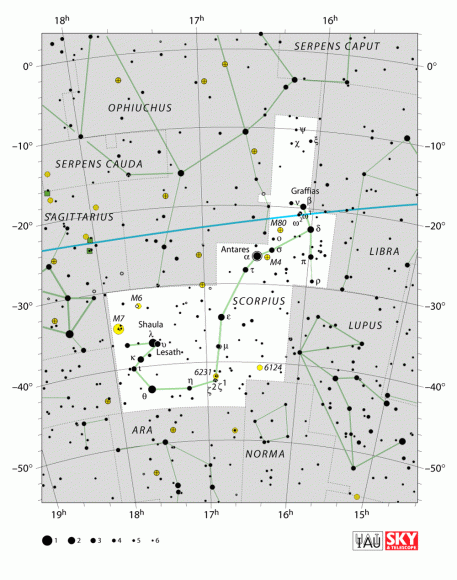
The Scorpius constellation, due to its position within the Milky Way, contains many deep-sky objects. These include the open clusters Messier 6 (the Butterfly Cluster) and Messier 7 (the Ptolemy Cluster), the open star cluster NGC 6231 (aka. Northern Jewel Box), and the globular clusters Messier 4 and Messier 80 (NGC 6093).
The constellation is also where the Alpha Scorpiids and Omega Scorpiids meteor showers take place. The Alphas begin on or about April 16th and end around May 9th, with a peak date of most activity on or about May 3rd. The second meteor shower, the Omega (or June) Scorpiids peaks on or about June 5th of each year. The radiant for this particular shower is closer to the Ophiuchus border and the activity rate on the peak date is high – with an average of about 20 meteors per hour and many reported fireballs.

Sagittarius: Nov. 22 – Dec. 21
The sign of Sagittarius covers 240° to 270° of celestial longitude and is represented by The Archer. This symbol is based on the centaur Chiron, who according to Greek mythology mentored Achilles in the art of archery. Sagittarius is part of the Ninth House – known as Iter (Journeys) or the House of Philosophy. Sagittarius’ associated element is Fire (positive polarity), and the ruling celestial body is Jupiter.
Stars of note in the Sagittarius constellation include Alpha Sagittarii, which is also known as Alrami or Rukbat (literally “the archer’s knee”). Then there is Epsilon Sagittarii (“Kaus Australis” or “southern part of the bow”), the brightest star in the constellation – at magnitude 1.85. Beta Sagittarii, located at a position associated with the forelegs of the centaur, has the traditional name Arkab, which is Arabic for “achilles tendon.”
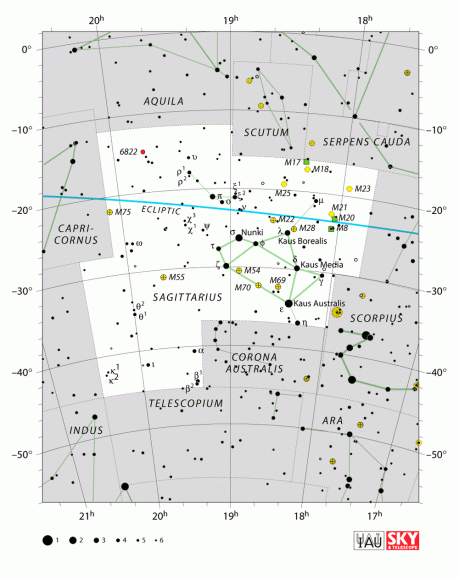
The second-brightest star is Sigma Sagittarii (“Nunki”), which is a B2V star at magnitude 2.08, approximately 260 light years from our Sun. Nunki is the oldest star name currently in use, having been assigned by the ancient Babylonians, and thought to represent the sacred Babylonian city of Eridu. Then there’s Gamma Sagittarii, otherwise known as Alnasl (the “arrowhead”). This is actually two star systems that share the same name, and both stars are actually discernible to the naked eye.
The Milky Way is at its densest near Sagittarius, since this is the direction in which the galactic center lies. Consequently, Sagittarius contains many star clusters and nebulae. This includes Messier 8 (the Lagoon Nebula), an emission (red) nebula located 5,000 light years from Earth which measures 140 by 60 light years.
Though it appears grey to the unaided eye, it is fairly pink when viewed through a telescope and quite bright (magnitude 3.0). The central area of the Lagoon Nebula is also known as the Hourglass Nebula, so named for its distinctive shape. Sagittarius is also home to the M17 Omega Nebula (also known as the Horseshoe or Swan Nebula).
This nebula is fairly bright (magnitude 6.0) and is located about 4890 light-years from Earth. Then there’s the Trifid Nebula (M20 or NGC 6514), an emission nebula that has reflection regions around the outside, making its exterior bluish and its interior pink. NGC 6559, a star forming region, is also associated with Sagittarius, located about 5000 light-years from Earth and showing both emission and reflection regions (blue and red).
![]()
Capricorn: Dec. 22 – Jan. 19
The sign of Capricorn spans 270° to 300° of celestial longitude and is represented by the Mountain Sea-Goat. This sign is based on Enki, the Sumerian primordial god of wisdom and waters who has the head and upper body of a mountain goat, and the lower body and tail of a fish. The sign is part of the Tenth House – Regnum (Kingdom), or The House of Social Status. Capricorns are associated with the element Earth, and the ruling body body is Saturn.

The brightest star in Capricornus is Delta Capricorni, also called Deneb Algedi. Like other stars such as Denebola and Deneb, it is named for the Arabic word for “tail”, which in this case translates to “the tail of the goat’. Deneb Algedi is a eclipsing binary star with a magnitude of 2.9, and which is located 39 light-years from Earth.
Another bright star in the Capricorni constellation is Alpha Capricorni (Algedi or Geidi, Arabic for “the kid”), which is an optical double star (two stars that appear close together) – both o which are binaries. It’s primary (Alpha² Cap) is a yellow-hued giant of magnitude 3.6, located 109 light-years from Earth, while its secondary (Alpha¹ Cap) is a yellow-hued supergiant of magnitude 4.3, located 690 light-years from Earth.
Beta Capricorni is a double star known as Dabih, which comes from the Arabic phrase “the lucky stars of the slaughter” a reference to ritual sacrifices performed by ancient Arabs. Its primary is a yellow-hued giant star of magnitude 3.1, 340 light-years from Earth, while the secondary is a blue-white hued star of magnitude 6.1. Another visible star is Gamma Capricorni (aka. Nashira, “bringing good tidings”), which is a white-hued giant star of magnitude 3.7, 139 light-years from Earth.
Several galaxies and star clusters are contained within Capricornus. This includes Messier 30 (NGC 7099) a centrally-condensed globular cluster of magnitude 7.5. Located approximately 30,000 light-years from our Sun, it cannot be seen with the naked eye, but has chains of stars extending to the north that can be seen with a telescope.
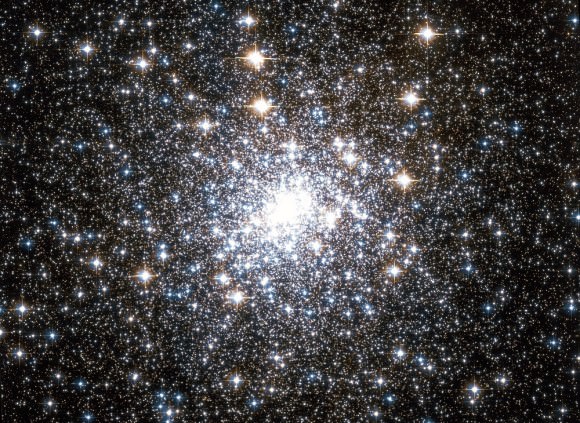
And then there is the galaxy group known as HCG 87, a group of at least three galaxies located 400 million light-years from Earth. It contains a large elliptical galaxy, a face-on spiral galaxy, and an edge-on spiral galaxy. These three galaxies are interacting, as evidenced by the high amount of star formation in the face-on spiral, and the connecting stream of stars and dust between edge-on spiral and elliptical galaxy.
The constellation of Capricornus has one meteor shower associated with it. The Capricornid meteor stream peaks on or about July 30th and is active for about a week before and after, with an average fall rate is about 10 to 30 per hour.
![]()
Aquarius: Jan. 20 – Feb. 18
Aquarius, which spans 300° to 330° of celestial longitude, is represented by the Water Bearer. In ancient Greek mythology, Aquarius is Ganymede, the beautiful Phrygian youth who was snatched up by Zeus to become the cup-bearer of the Gods. Aquarius is part of the Eleventh House – Benefacta (Friendship), or House of Friendship, is associated with the element of Air. Traditionally, the ruling celestial body of Aquarius was Saturn, but has since changed to Uranus.
While Aquarius has no particularly bright stars, recent surveys have shown that there are twelve exoplanet systems within the constellation (as of 2013). Gliese 876, one of the nearest stars (15 light-years), was the first red dwarf start to be found to have a planetary system – which consists of four planets, one of which is a terrestrial Super-Earth. 91 Aquarii is an orange giant star orbited by one planet, 91 Aquarii b, a Super-Jupiter. And Gliese 849 is a red dwarf star orbited by the first known long-period Jupiter-like planet, Gliese 849 b.
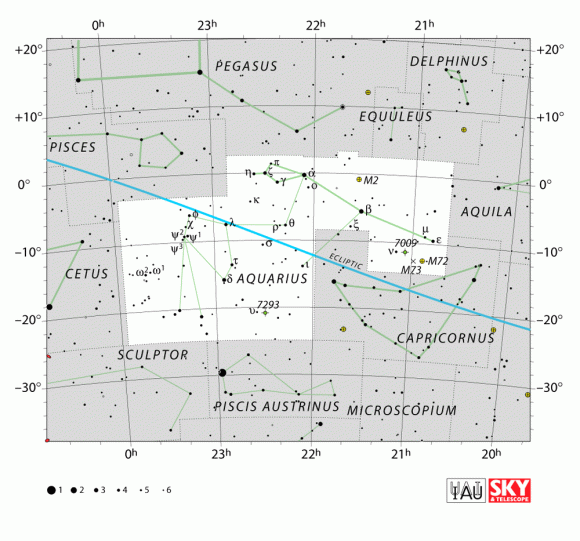
Aquarius is also associated with multiple Messier objects. M2 (NGC 7089) is located in Aquarius, which is an incredibly rich globular cluster located approximately 37,000 light-years from Earth. So is the four-star asterism M73 (which refers to a group of stars that appear to be related by their proximity to each other). Then there’s the small globular cluster M72, a globular cluster that lies a degree and half to the west of M73.
Aquarius is also home to several planetary nebulae. NGC 7293, also known as the Helix Nebula, is located at a distance of about 650 light years away, making it the closest planetary nebula to Earth. Then there’s the Saturn Nebula (NGC 7009) so-named because of its apparent resemblance to the planet Saturn through a telescope, with faint protrusions on either side that resemble Saturn’s rings.
There are five meteor showers associated with the constellation of Aquarius. The Southern Iota Aquarids begin around July 1st and end around September 18th, with the peak date occurring on August 6th with an hourly rate of 7-8 meteors average. The Northern Iota Aquarids occur between August 11th to September 10th, their maximum peak occurring on or about August 25th with an average of 5-10 meteors per hour.
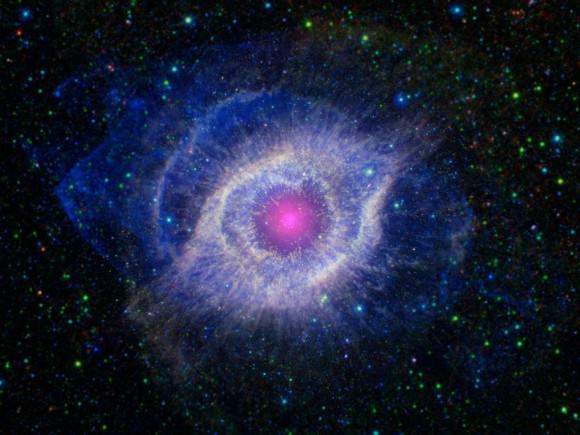
The Southern Delta Aquarids begin about July 14th and end around August 18th with a maximum hourly rate of 15-20 peaking on July 29th. The Northern Delta Aquarids usually begin around July 16th, and last through September 10th. The peak date occurs on or around August 13th with a maximum fall rate of about 10 meteors per hour.
Then there is the Eta Aquarid meteor shower, which begins about April 21th and ends around May 12th. It reaches its maximum on or about May 5th with a peak fall rate of up to 20 per hour for observers in the northern hemisphere and perhaps 50 per hour for observers in the southern hemisphere. Last, there is the March Aquarids, a daylight shower that may be associated with the Northern Iota Aquarid stream.

Pisces: Feb. 19 – March 20
The sign of Pisces covers 330° to 360° of celestial longitude and is represented by the The Fish. This symbol is derived from the ichthyocentaurs – a pair of centaurian sea-gods that had the upper body of a male human, the lower front of a horse, and the tail of a fish – who aided Aphrodite when she was born from the sea. Pisces is part of the Twelfth House of Carcer (Prison), or The House of Self-Undoing, and are associated with the element of Water. The ruling celestial body of Pisces is traditionally Jupiter, but has since come to be Neptune.
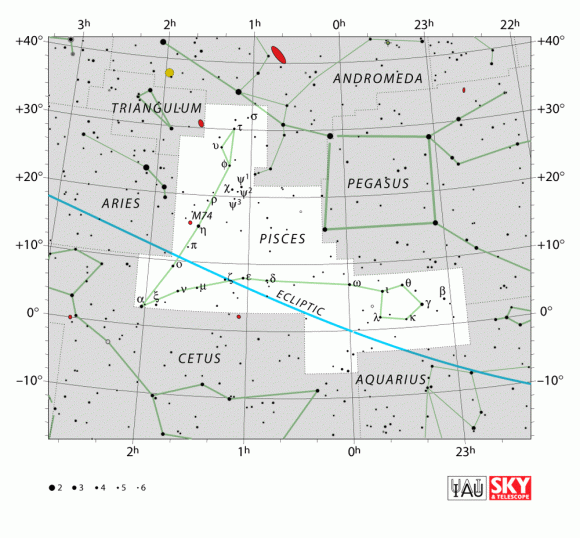
Beta Piscium, also known as Samakah (the “Fish’s Mouth”), is a B-class hydrogen fusing dwarf star in the Pisces constellation. Located 495 light years from Earth, this star produces 750 times more than light than our own Sun and is believed to be 60 million years old. The brightest star in the constellation, Eta Piscium, is a bright class B star that is located 294 years away from our Solar System.
This star is also known by its Babylonian name, Kullat Nunu (which translates to “cord of the fish”), the Arab name Al Pherg (“pouring point of water”), and the Chinese name Yòu Gèng – which means “Official in Charge of the Pasturing“, referring to an asterism consisting of Eta Piscium and its immediate neighbors – Rho Piscium, Pi Piscium, Omicron Piscium, and 104 Piscium.
And then there’s van Maanen’s Star (aka. Van Maanen 2) a white dwarf that is located about 14 light years from our Sun, making it the third closest star of its kind to our system (after Sirius B and Procyon B). Gamma Piscium is a yellow-orange giant star located about 130 light years away, and is visible with just binoculars.
The Pisces constellationis also home to a number of deep-sky objects. These include M74, a loosely-wound spiral galaxy that lies at a distance of 30 million light years from our Sun. It has many clusters of young stars and the associated nebulae, showing extensive regions of star formation. Also, there’s CL 0024+1654, a massive galaxy cluster that is primarily made up of yellow elliptical and spiral galaxies. CL 0024+1654 lies at a distance of 3.6 billion light-years from Earth and lenses the galaxy behind it (i.e. it creates arc-shaped images of the background galaxy).
Last, there the active galaxy and radio source known as 3C 31. Located at a distance of 237 million light-years from Earth, this galaxy has a supermassive black hole at its center. In addition to being the source of its radio waves, this black hole is also responsible for creating the massive jets that extend several million light-years in both directions from its center – making them some of the largest objects in the universe.
There is one annual meteor shower associated with Pisces which peaks on or about October 7 of each year. The Piscid meteor shower has a radiant near the Aries constellation and produces an average of 15 meteors per hour which have been clocked at speeds of up to 28 kilometers per second. As always, the meteoroid stream can begin a few days earlier and end a few days later than the expected peak and success on viewing depends on dark sky conditions.
Currently, the Vernal Equinox is currently located in Pisces. In astronomy, equinox is a moment in time at which the vernal point, celestial equator, and other such elements are taken to be used in the definition of a celestial coordinate system. Due to the precession of the equinoxes, the Vernal Equinox is slowly drifting towards Aquarius.
Astrology is a tradition that has been with us for thousands of years and continues to be observed by many people and cultures around the world. Today, countless people still consult their horoscope to see what the future has in store, and many more consider their birth sign to be of special significance.
And the fact that many people still consider it to be valid is an indication that superstitious and “magical” thinking is something we have yet to completely outgrow. But this goes to show how some cultural traditions are so enduring, and how people still like to ascribe supernatural powers to the universe.
We have a complete guide to all 88 constellations here at Universe Today. Research them at your leisure, and be sure to check out more than just the “zodiac sign” ones!
We also have a comprehensive list of all the Messier Objects in the night sky.
Astronomy Cast also has an episode on Zodiac Signs – Episode 319: The Zodiac


